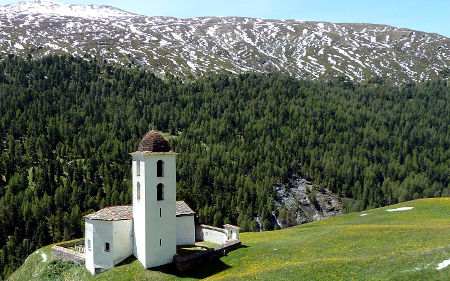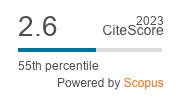Swiss tree lines - a GIS-based Approximation
DOI:
https://doi.org/10.3097/LO.201228Keywords:
Forest line, Geographic information system, GIS, Moving-window analysis, Reforestation, Switzerland, Tree lineAbstract
Mountain timber lines are relevant in the context of land abandonment and climate change. For Switzerland, GIS-compliant delimitations of the tree line and the forest line are still lacking. Recent high-resolution landcover information offers new possibilities for GIS-based approaches. In a Swiss-wide study, an analysis based on slope zones was combined with a moving-window analysis to assess tree and forest line altitude, using topographic data. The tree and the forest lines were delimited at the upper altitude reached by a tree or closed forest respectively. The model delivered a fine-scaled delimitation sensitive to local conditions. The results indicate that earlier studies underestimated the tree line altitudes for the fringes of the Alps. Also the variability inside climatic and bio-geographical regions is larger than it was estimated up to now.
References
BAFU, & BLW. (2008). Umweltziele landwirtschaft. hergeleitet aus bestehenden rechtlichen grundlagen. Umweltziele Landwirtschaft.Hergeleitet Aus Bestehenden Rechtlichen Grundlagen,
Bätzing, W. (2003). Die Alpen.Geschichte Und Zukunft Einer Europäischen Kulturlandschaft,
Baur, P., Bebi, P., Gellrich, M., & Rutherford, G. (2006). WASALP - Waldausdehung Im Schweizer Alpenraum: Eine Quantitative Analyse Naturräumlicher Und Sozioökonomischer Ursachen Unter Besonderer Berücksichtigung Des Agrarstrukturwandels,
Brockmann-Jerosch, H. (1919). Baumgrenze Und Klimacharakter,
Brockmann-Jerosch, H. (1928). Meereshöhen Der Baumgrenze in Der Schweiz (Map of Climatic Treeline Elevations in Switzerland) 1 600 000,
Burga, C. A., Klötzli, F., & Miehe, G. (2004). Waldgrenze: Phänomen Und Globaler Vergleich, , 20-21.
Danzeglocke, J. (2005). Remote sensing of upper timberline elevation in the alps on different scales. Remote Sensing of Upper Timberline Elevation in the Alps on Different Scales, , 145-151.
Dirnböck, T., Dullinger, S., & Grabherr, G. (2003). A regional impact assessment of climate and land-use change on alpine vegetation. Journal of Biogeography, 30(3), 401-417. doi:10.1046/j.1365-2699.2003.00839.x
Dullinger, S., Dirnböck, T., Greimler, J., & Grabherr, G. (2003). A resampling approach for evaluating effects of pasture abandonment on subalpine plant species diversity. Journal of Vegetation Science, 14(2), 243-252. doi:10.1111/j.1654-1103.2003.tb02149.x
Eggenberg, S. (2002). Die waldgrenzvegetation in unterschiedlichen klimaregionen der alpen: Cramer in der gebr.-borntraeger-verl.-buchh, berlin. Die Waldgrenzvegetation in Unterschiedlichen Klimaregionen Der Alpen, , 1-157.
Ellenberg, H. (1986). Vegetation Mitteleuropas Mit Den Alpen in Ökologischer Sicht,
Gehrig-Fasel, J., Guisan, A., & Zimmermann, N. E. (2007). Tree line shifts in the swiss alps: Climate change or land abandonment? Journal of Vegetation Science, 18(4), 571-582. doi:10.1658/1100-9233(2007)18[571:TLSITS]2.0.CO;2
Hess, H. E., Landolt, E., & Hirzel, R. (1976). Flora Der Schweiz Und Angrenzender Gebiete,
Holtmeier, F. -. (2003). Mountain Timberlines: Ecology, Patchiness, and Dynamics,
Holtmeier, F. -., & Broll, G. (2007). Treeline advance - driving processes and adverse factors. Landscape Online, 1(1), 1-33. doi:10.3097/LO.200701
Hotz, M. C., & Weibel, F. (2005). Wald Und Gehölze, , 64-76.
Hunziker, M. (1995). The spontaneous reafforestation in abandoned agricultural lands: Perception and aesthetic assessment by locals and tourists. Landscape and Urban Planning, 31(1-3), 399-410. doi:10.1016/0169-2046(95)93251-J
Imhof, E. (1900). Die waldgrenze in der schweiz, gerlands beitr. Gerland’s Beitrage Zur Geophysik, 4(3), 241-330.
Körner, C. (1999). Alpine Plant Life,
Kruckeberg, A. R. (2002). Geology and Plant Life: The Effects of Landforms and Rock Types on Plants,
Landolt, E. (1992). Unsere alpenflora. Unsere Alpenflora,
Mack, G., Walter, T., & Flury, C. (2008). Entwicklung Der Alpung in Der Schweiz: Ökonomische Und Ökologische Auswirkungen, , 259-300.
Paulsen, J., & Körner, C. (2001). GIS-analysis of tree-line elevation in the swiss alps suggests no exposure effect. Journal of Vegetation Science, 12(6), 817-824. doi:10.2307/3236869
Schmid, E. (1961). Erläuterungen zur vegetationskarte der schweiz. Beitr.Geobot.Landesaufn.Schweiz, 39
Schüepp, M., & Gensler, G. (1980). Klimaregionen der schweiz. (1980): Die Beobachtungsnetze Der Schweizerischen Meteorologischen Anstalt.- Arbeitsberichte Der Schweizerischen Meteorologischen Anstalt,
SFSO. (2001). Arealstatistik 1992/1997,
Szerencsits, E., Schüpbach, B., Conradin, H., Grünig, A., & Walter, T. (2009). Agrarlandschaftstypen Der Schweiz,
Tomlin, C. D. (1990). Geographic Information Systems and Cartographic Modeling,
Wardle, P. (1974). Alpine timberlines. Arctic and Alpine Environments, , 371-402.
Welten, M., & Sutter, R. (1982). Verbreitungsatlas Der Farn- Und Blütenpflanzen Der Schweiz,
Wieser, G., & Tausz, M. (2007). Current concepts for treelife limitation at the upper timberline. Trees at their Upper Limit, , 1-18.
Wohlgemuth, T. (1993). The distribution atlas of pteridophytes and phanerograms of switzerland (welten and sutter 1982) in a relational database: Species number per mapping unit and its dependence on various factors. [Der Verbreitungsatlas der Farn- und Blutenpflanzen der Schweiz (Welten und Sutter 1982) auf EDV: Die Artenzahlen und ihre Abhangigkeit von verschiedenen Faktoren] Botanica Helvetica, 103(1), 55-71.

Downloads
Published
How to Cite
Issue
Section
License
Copyright (c) 2019 Erich Szerencsits

This work is licensed under a Creative Commons Attribution 4.0 International License.










